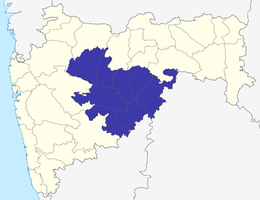Marathwada

Marathwada ( Marathi : मराठवाडा) is a historical region in what is now the Indian state of Maharashtra ; it belonged to the princely state of Hyderabad from 1724 to 1956 , is almost identical in area to today's Aurangabad (division) and has around 20 million inhabitants.
geography
The approximately 64,000 km² region of Marathwada is located on the Dekkan Plateau, which is about 500 to 800 m high, and occupies the southeast of Maharashtra. It includes the 8 districts of Aurangabad , Nanded , Latur , Parbhani , Jalna , Beed , Hingoli and Osmanabad . Most important cities are Aurangabad , Nanded-Waghala and Latur . The most important river is the Godavari , which, however, in the Marathwada region - despite above-average annual rainfall of 750 to 900 mm - has no major tributaries with the exception of the Manjira .
history
In the phase of the decline of the Mughal empire , which ruled the area since the late 17th century, the local governor Asaf Jah I , who bore the title Nizām al-Mulk (= "folder of the empire") , made himself in 1724 de facto independent and founded the princely state of Hyderabad, which, however, gradually came under British influence. While Telugu was mainly spoken in and around Hyderabad , Marathi was spoken in the northwest - from this situation the area was given the name Marathwadi (“Houses of the Marathi”). After Indian independence (1947) it remained with Hyderabad State , but was added to Bombay State under the States Reorganization Act in 1956 , from which the states of Maharashtra and Gujarat emerged in 1960 .
Attractions
The most important sights of the Marathwada region are located in and around the city of Aurangabad: the Buddhist cave monasteries of Ellora and Ajanta are among the most impressive in all of India, the fortress city of Daulatabad and the tombs of Khuldabad are reminiscent of the late medieval and modern phase of dominance of Islam . In the entire region there is almost no medieval Hindu temple anymore, because they were razed during Aurangzeb's Deccan campaigns ; only the half-destroyed temple of Aundha Nagnath reminds of this time. Many temples, including the Grishneshwar Jyotirlinga temple near Ellora or the temples of Ambajogai or Tuljapur , were completely or in major parts renovated between the 17th and 19th centuries. The Hazur Sahib Sikh Gurdwara in Nanded is one of the most important religious centers of the faith community.
literature
Web links
- Marathwada Statutory Development Board (various information, English)





